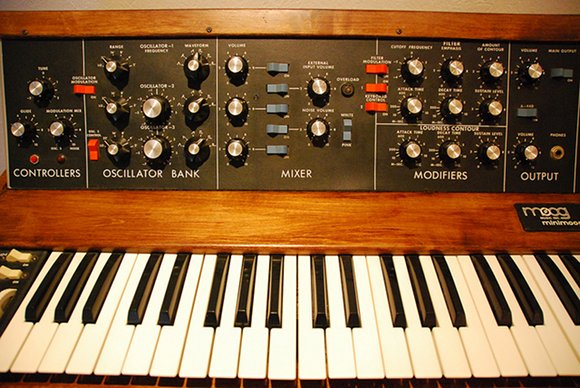
The Moog Minimoog has turned 40 years old. I got to write the cover story for this month’s Keyboard Magazine, following the history of the keyboard. I chronicled the details of the original Minimoog’s evolution largely through the accounts of Bill Hemsath, the man who built the first prototype of a synth imagined and developed by Hemsath, Bob Moog, Jim Scott, and Chad Hunt.
Whatever you make – music, hardware, software – the tale of the Minimoog’s birth through accident is especially compelling. Through Hemsath’s eyes, I revisited that genesis for Keyboard.
The future of the synth may have been determined by just which junked and cannibalized parts lay in storage. “There was a five-octave keyboard that [Bob] would steal key caps off of to replace chipped and broken ones,” Hemsath remembers. “Then there was an upper console case—it was four feet long but the end was broken out. So I got to work on the keyboard. The number of remaining keycaps determined its size, which turned out to be three octaves. So I hacksawed that down. There was a smashed keyboard case, and I cut it down to match. Originally, [Bob] had the portamento control on the left cheek. That was missing, so there was a little notch in the left cheek. And I needed something there. Well, how about a slider? That’d fit. So the forerunner of the wheel was that slide pot, just to fill that space.”
The result was the shell of what would become the Model A, the first Minimoog prototype. Hemsath bolted together modules from spare and rejected parts. “I’d sit down at my desk and take an apple out of one drawer and a module out of the other,” he says. By his count, just one model 901A oscillator was fresh stock; everything else was salvaged from Moog’s junk bin.
Actually, to me, it’s partly Hemsath story that badly needed telling – Bob Moog is a household name, but only the biggest synth history gurus know Hemsath. I’m deeply indebted to the Moog Foundation for allowing me to transcribe an interview with him they did just this summer; this is exactly the kind of work the foundation is doing to preserve the history of synthesis in general – Moog and beyond – and another reason why you should support their work.
Michelle Moog-Koussa, without whom I couldn’t have written this story, also has a must-read article from the same issue:
Bob Moog Lives
She details her father’s legacy, and the work the foundation does to reach out to students, their plans for a dream laboratory and museum, and more.
Of course, Moog isn’t just history, so for the we follow the parallel lines: Minimoog, Bob Moog, and the 70s, and then the ability of Dr. Moog to return to his vision with a reborn Moog Music company and the Voyager.
You can read the full story online:
The Minimoog at 40: From the Dawn of the Synth Age to New Voyages [Keyboard Magazine]
— but if you can get the newsstand copy, it’s well worth it for the nearly-pornographic foldout cover of the new Minimoog XL. Yes, we know your rational problems with the price or functionality of this instrument. No, it doesn’t change the visceral emotional reaction it inspires.
Thanks to Steve at Keyboard for the dream assignment, and to Emmy, Chris, and the crew at Moog Music, and Michelle at the Moog Foundation, for helping us put this together.